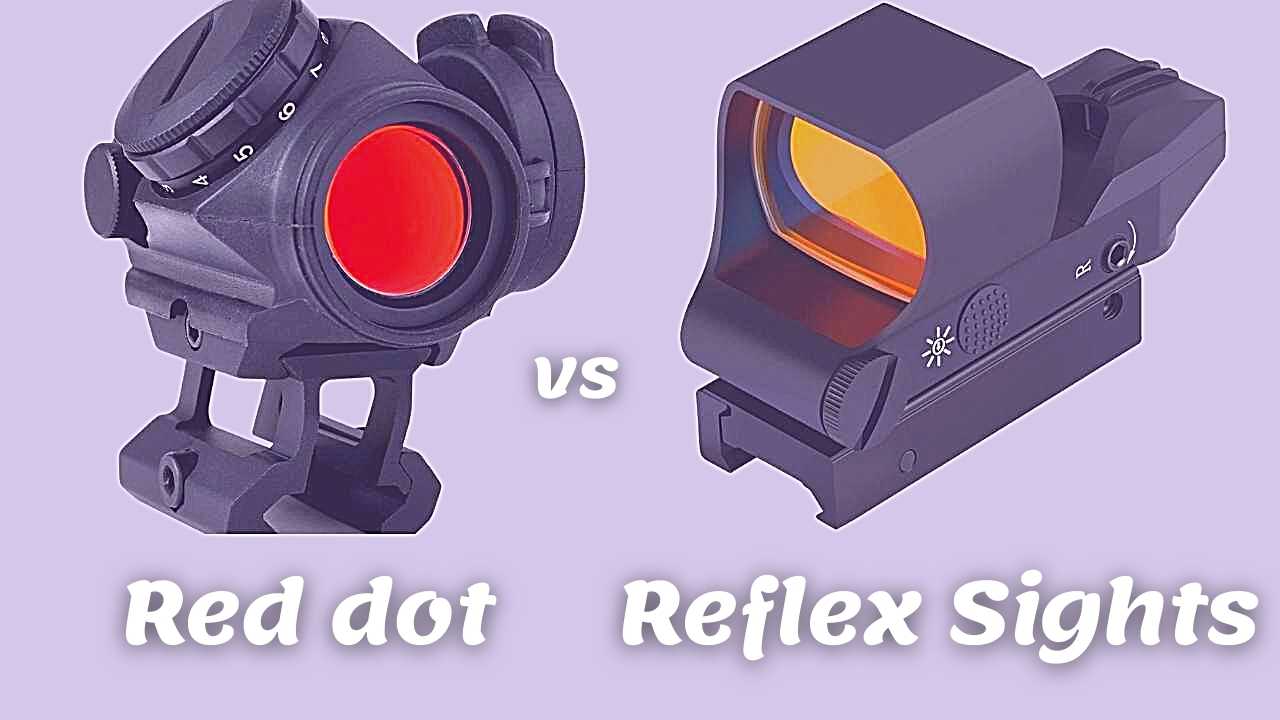
Before explaining the differences between a red dot sight and a Reflex sight, it is essential to know that Red dot sight is not a specific sight but a category of electronic sights that includes non-magnified sights that use a red dot as its reticle. Several different types of sights fall in this category, and a reflex sight is one of them. It is usually said that all reflex sights are red dots, but not all red dots are reflex sights.
In this way, a reflex sight is also a red dot sight as it is part of the general category of red dot sights. However, there are some significant differences to consider between the two sights in comparison here.
What is Reflex Sight
A Reflex sight is part of the red dot sights. It uses an LED and a mirror lens. The beam that is reflected by the LED is in the form of a red dot. The beam is emitted from the rear lens and captured and reflected by the front lens creating the illuminated red dot reticle which the shooter sees. This is the basis of working on a reflex sight and hence got the name reflex sight. This working principle of a reflex sight is what differentiates it from a red dot. There are two types of reflex sights. The first one is a tube reflex sight. It consists of a cylindrical tube. It includes two lenses. The rear lens projects the light, and the front one reflects it. It is more protected and can suffer more abuse.
The second one is an exposed reflex sight. It has a square-shaped open window that makes it more compact. It consists of a single lens. The advantage of using an open reflex sight is that it does not obstruct the view and thus gives more situational awareness.
What is Red Dot Sight
Usually, any sight that uses a red dot as its reticle is called a red dot sight. This category includes holographic sights, prism sights, and reflex sights as well. But the working of a red dot sight and other sights explain how red dot sight is different from other sights in this category. It uses a simple red dot as its reticle. The red dot is designed in a tube dot system. It uses an LED dot in the middle. It uses LED and mirrors to create a red dot used as a reticle. A red dot sight does not include magnification which means that the power of the red dot cannot be increased.
Red dot vs Reflex Sights
Field of view
A red dot sight gives a minimum field of view. A red dot sight is more prominent as compared to a reflex sight. Its tubelike structure, when put in the field, obstructs most of the view. In comparison to this, a reflex sight and especially an open reflex sight is compact and does not obstruct much of the view of the field. It helps to give more situational awareness. The shooter can better analyze what is happening around him.
Reticle comparison
The reticle of the red dot sight and the reflex sight appears on the screen for the user and does not reflect the target. Also, both the reticles are illuminated. These are some similarities between the two reticles. However, what is different is that a red dot sight uses a simple red dot reticle. On the other hand, a reflex sight has different types of reticles. These four reticles are a circle with a dot reticle, crosshair reticle, simple red dot, and circle dot with crosshair extending from outside the circle. These four different types of reticles give additional options for the shooters to choose from according to their preferences.
Eye relief
Eye relief depicts how much far the sight can be placed from the eye and would still work. More eye relief is essential to keep the eyes relaxed, and those who need to wear prescription glasses also need more eye relief. A reflex sight has unlimited eye relief. It is due to the small and compact design of a reflex sight. A red dot does not have magnification. Hence it also provides sufficient eye relief.
Price
Both red dot and reflex sight comes in the category of inexpensive weapon sights. Reflex sights are one of the most commonly used weapon sights available. One factor that makes it widely used is its low price.
On the other hand, a red dot sight is much more affordable than other expensive sights, such as a holographic sight or a prism sight, but it is more costly than a reflex sight.
Advantages
A red dot is preferred by beginner and advanced shooters alike. This is due to its accuracy and precision. Aiming a target becomes far accurate and precise while using a red dot sight. Also, you can use red dot sight with both eyes open, which gives better situational awareness. A critical advantage of a red dot sight is that it is energy efficient. It uses LED technology which does not require to consume a lot of energy for its work.
A reflex sight has unlimited eye relief. It also has long battery life. It enables the shooters to lock the target quickly. It is compact and lightweight. It has a larger field of view, and it further has brighter reticles.
FAQS
Which company manufactures red dot sights?
- Aimpoint global is the most recognized company that produces red dot sights. It is
- also, the original manufacturer of red dot sights.
What are some popular Red dot sights?
- Bushnell Red Dot Sight
- Vortex Optics Strikefire II
- Trijicon RMR 6.5 MOA
What are some popular Reflex sights?
- Ohuhu Reflex Sight
- Feyachi Reflex Sight
- Pinty Red Green Reflex Sight
Can a Red dot sight work for long-range shooting?
Yes, a red dot sight can work for long-range shooting as red dot sights are made for fast target acquisition at closed range. Hence, it will require a magnifier for enhancing the view at long ranges.
